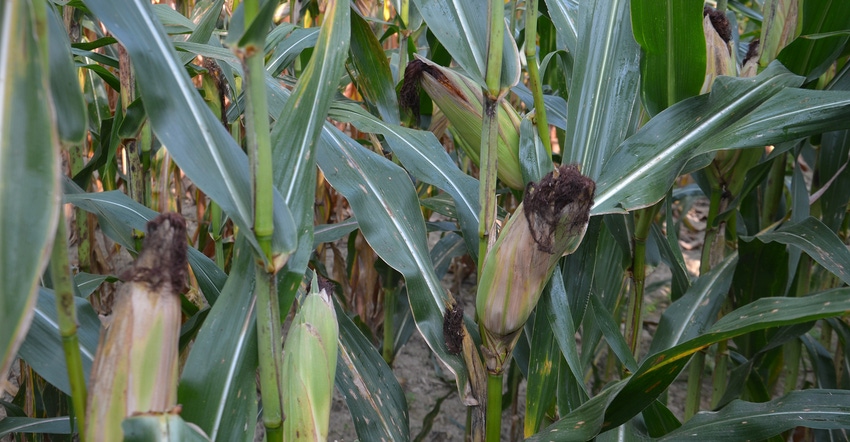
Dave Nanda believes in applying fungicides to corn during the reproductive stage under two conditions. First, the hybrid is at least somewhat susceptible to foliar diseases. Second, there are disease lesions present. He found that both criteria were met while inspecting the Corn Watch ’20 field in early August.
“We visited the field just a few weeks before, and leaves were clean,” Nanda recalls. “But when we returned when ears were silked out, gray leaf spot was getting a solid start on lower leaves. Some lesions were even appearing on ear leaves.”
Nanda, director of genetics for Seed Genetics Direct, sponsor of Corn Watch ’20, notified the grower about what he saw as soon as he left the field. As it turns out, the grower was scouting, too. He had intended to spray the field with a high-clearance rig a few days earlier, but a heavy rainstorm interfered. While he welcomed the rain, he knew it would mean altering his plans to apply fungicide.
Fungicide was aerially applied that evening after Nanda visited the field. The farmer figures he gets better coverage with his own ground rig, but the soil was still too tacky to drive the field, and he knew he was running out of time to shut down the disease.

GRABBED FOOTHOLD: Gray leaf spot was setting itself up for a feast when this picture was taken in early August, before fungicide was applied.

Just over a month later, Nanda returned and assessed the results of that fungicide application. It was early September, and both hybrids in the field were at or nearly at black layer. “The grower made a good decision to spray the field when he did,” Nanda says.
“It looked like gray leaf spot was frozen in time,” he explains. “We still saw lesions on the lower leaves, but saw only a few scattered lesions on ear leaves and the leaves above them. It’s the upper leaves on a corn plant that are critical during the grain fill period. You need to keep them as healthy as possible for as long as possible so that plants continue to fill kernels.”

2 DISEASES: Dave Nanda found both gray leaf spot and southern corn leaf blight, denoted by the irregular lesions, on this leaf at black layer. But these diseases likely will have little or no impact on yield.

So, although there are no check strips in the field where fungicide wasn’t applied, Nanda is confident that spraying fungicide yielded a big payoff in this instance.
“There was plenty of moisture here in early August, and the disease would have kept progressing,” Nanda says. “We would have likely seen premature dying before kernels reached black layer. When you shut the photosynthetic factory down early, you sacrifice yield.”
About the Author(s)
You May Also Like




